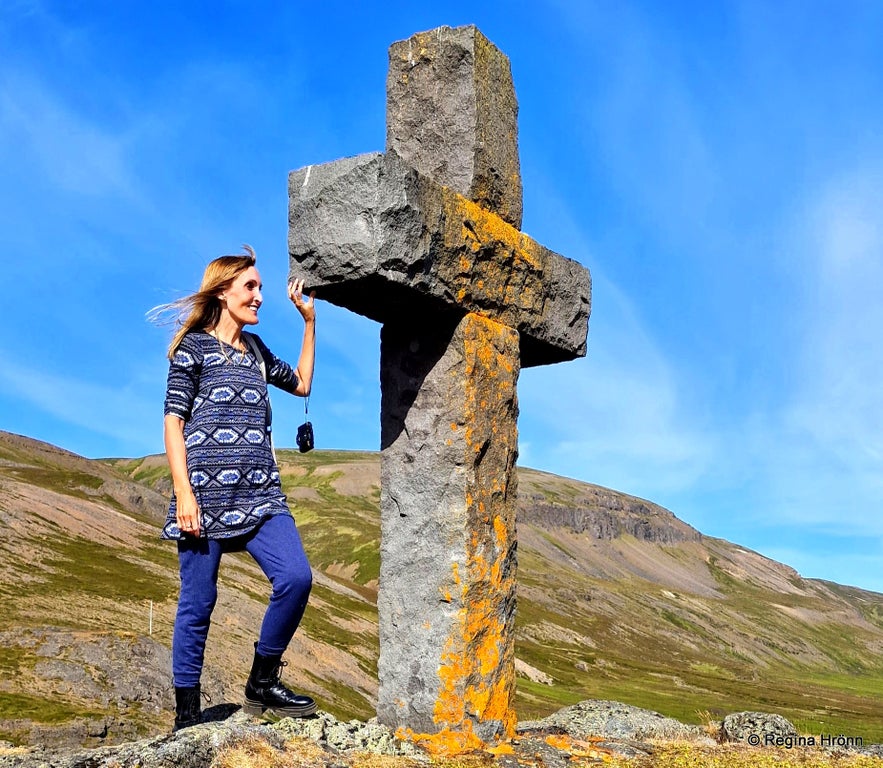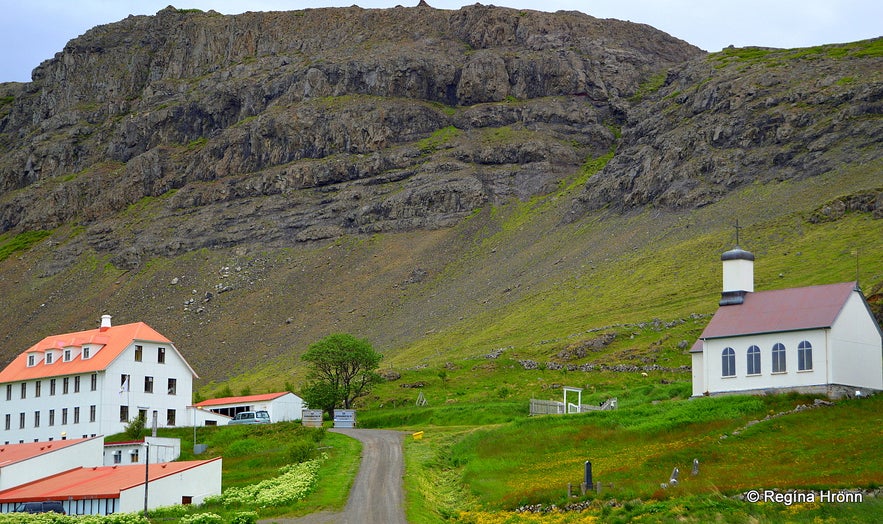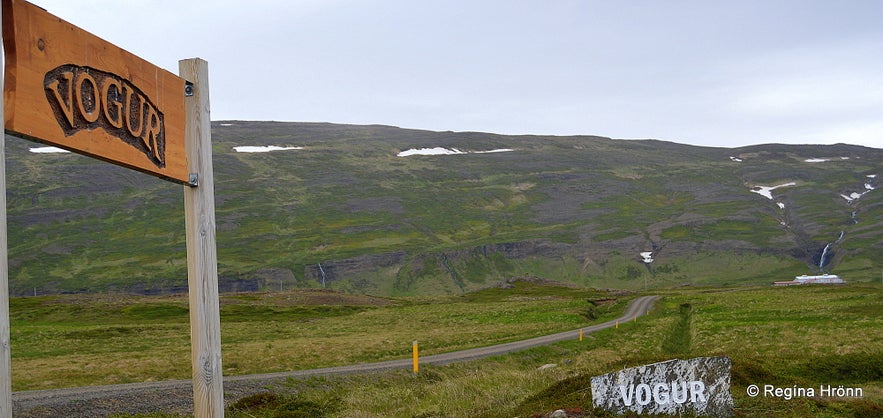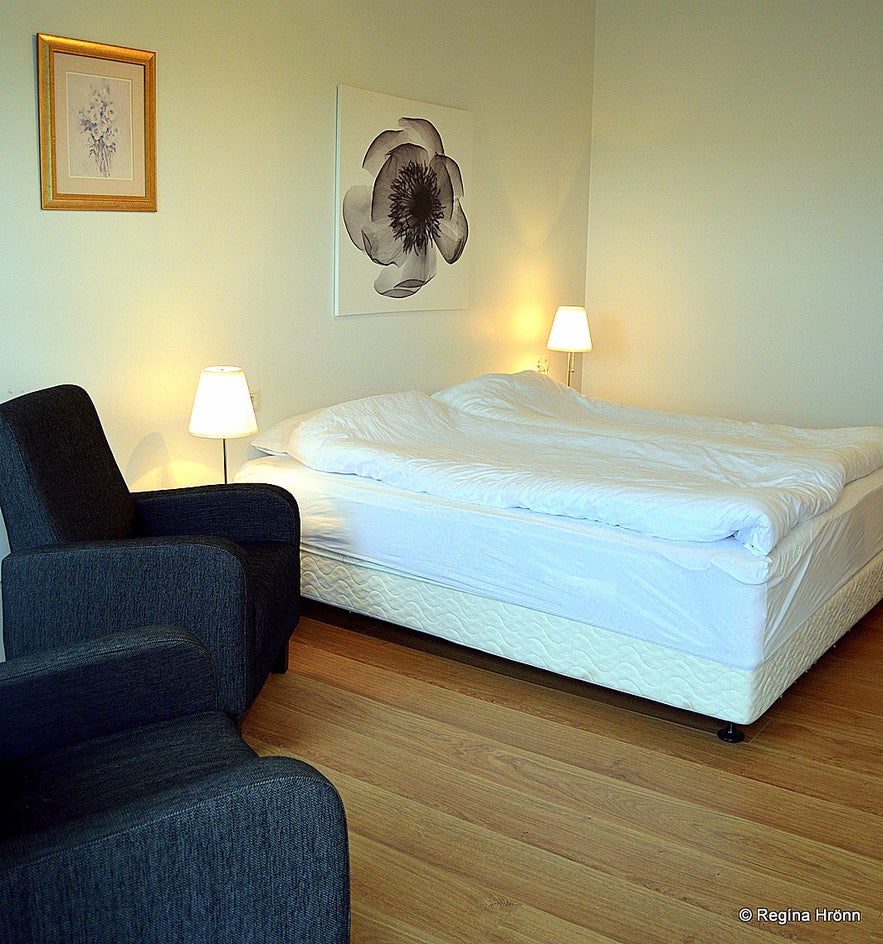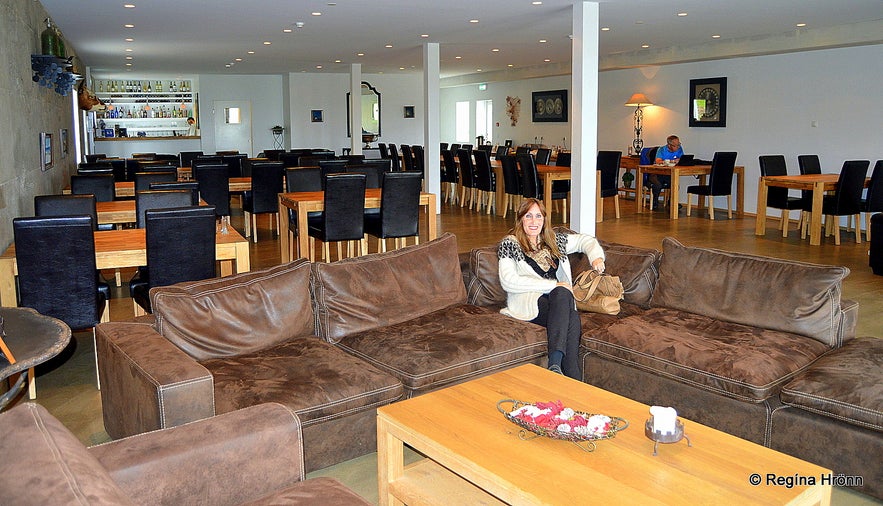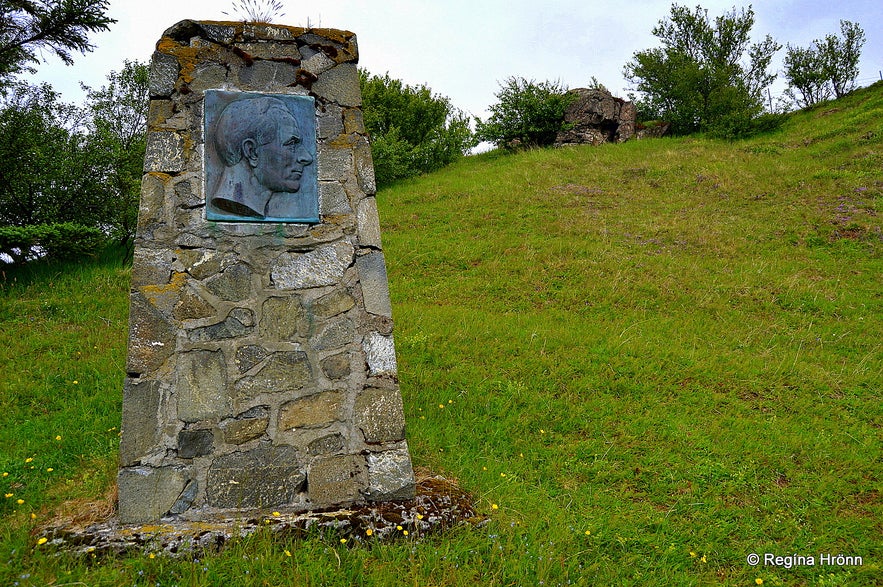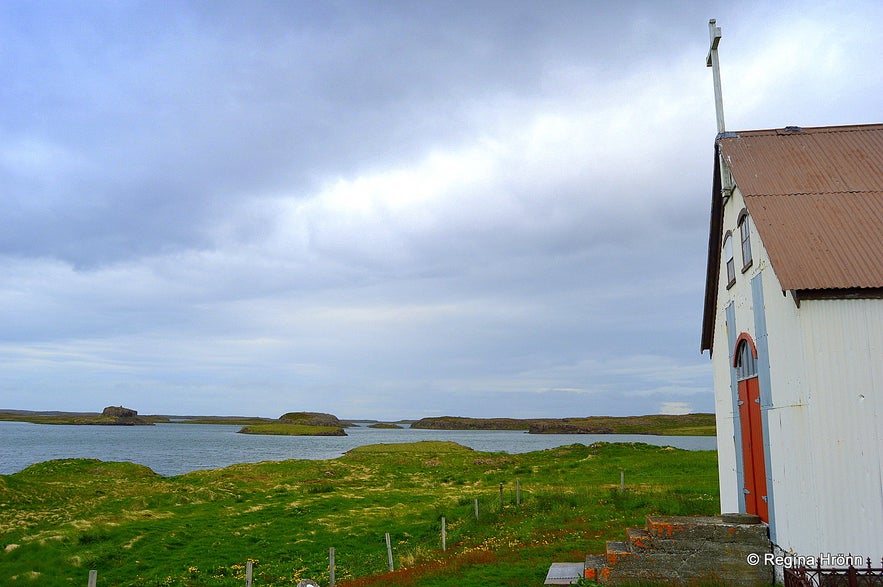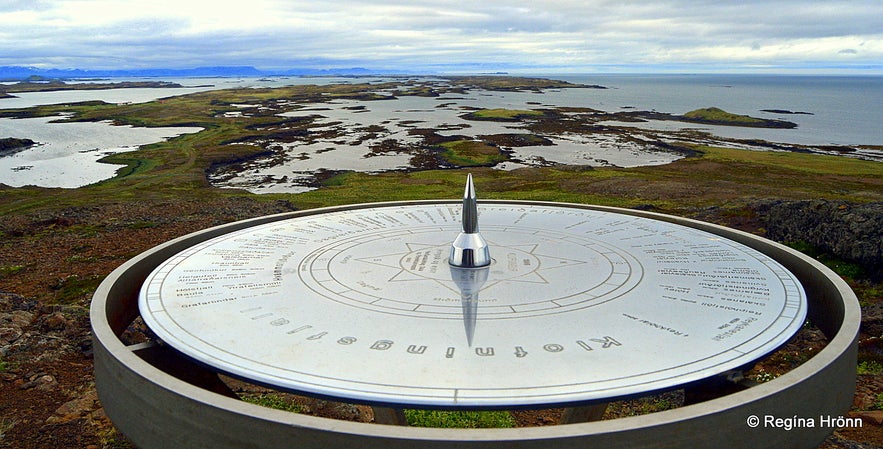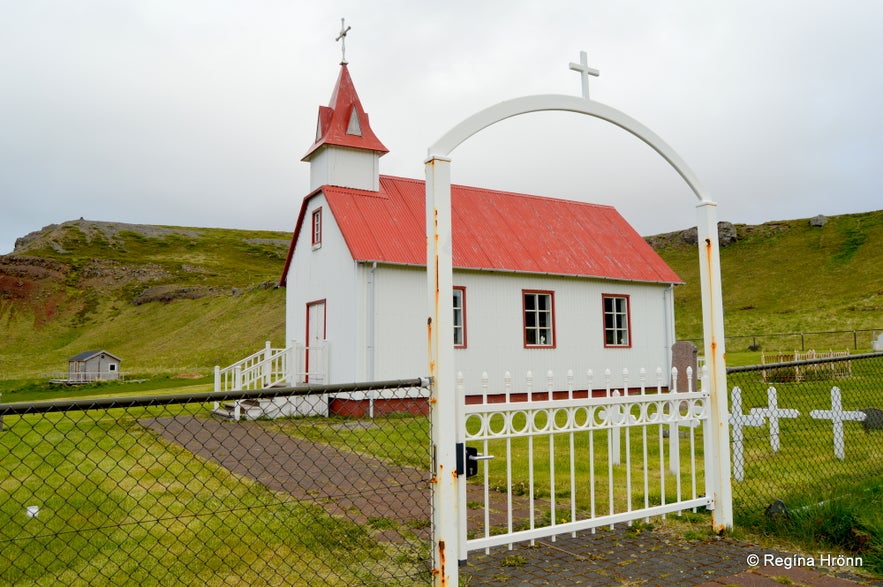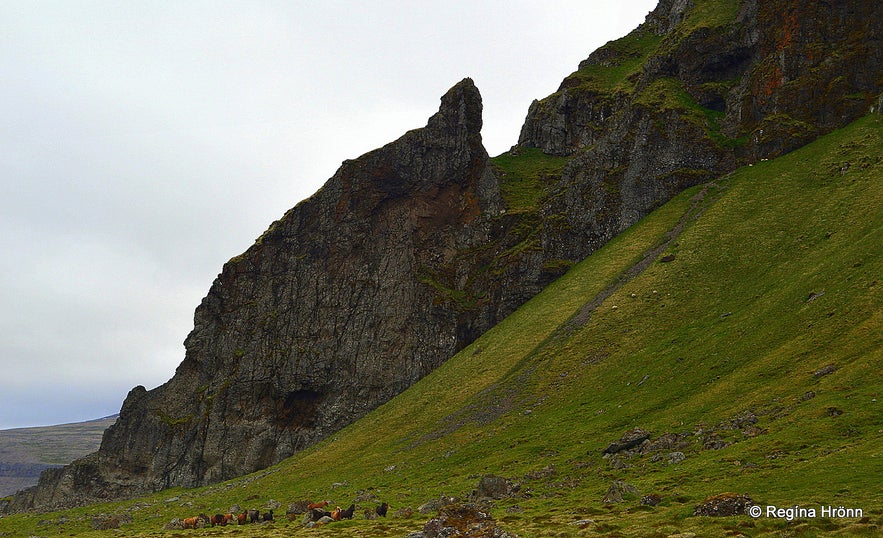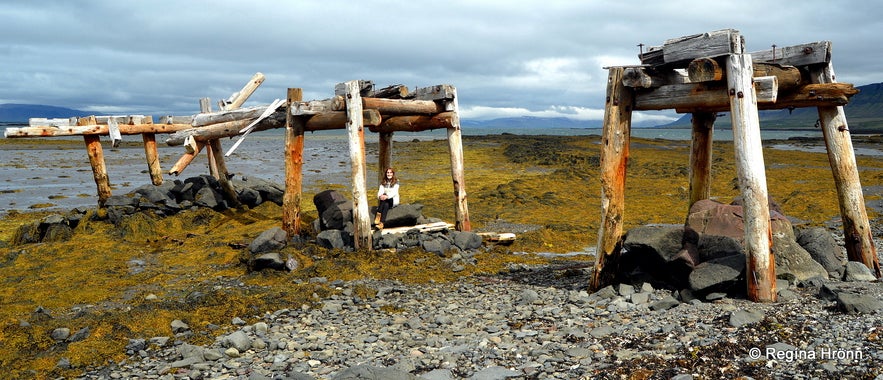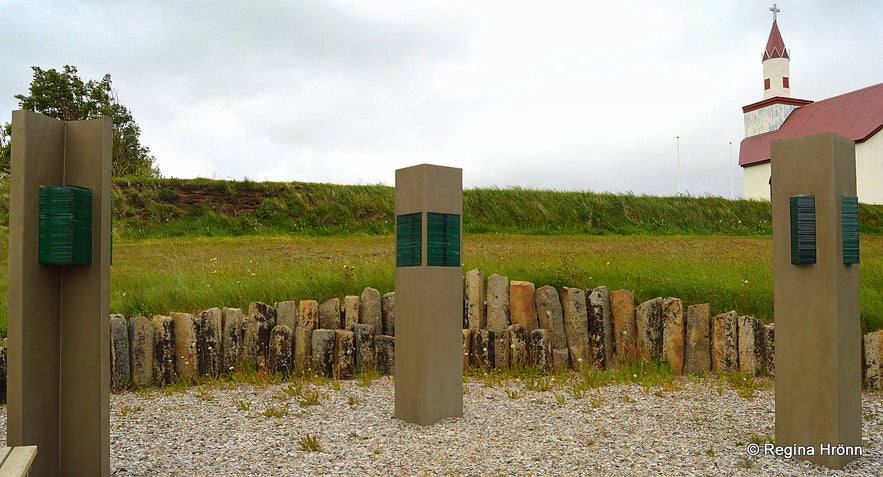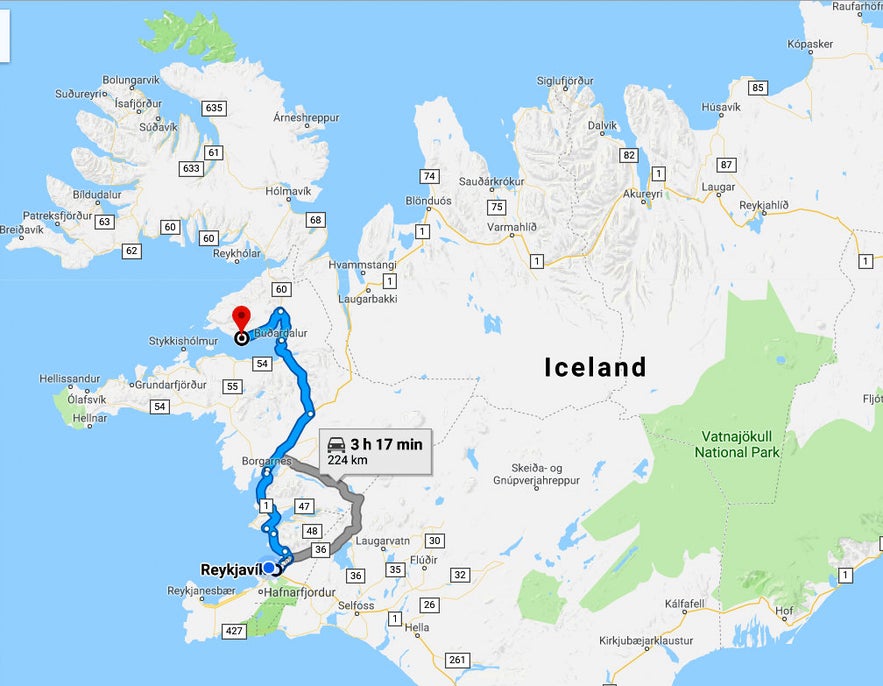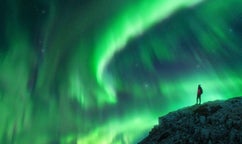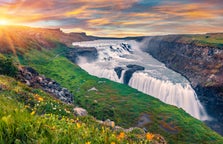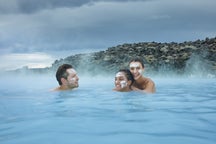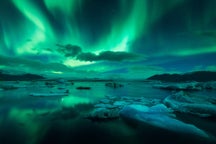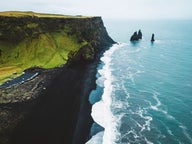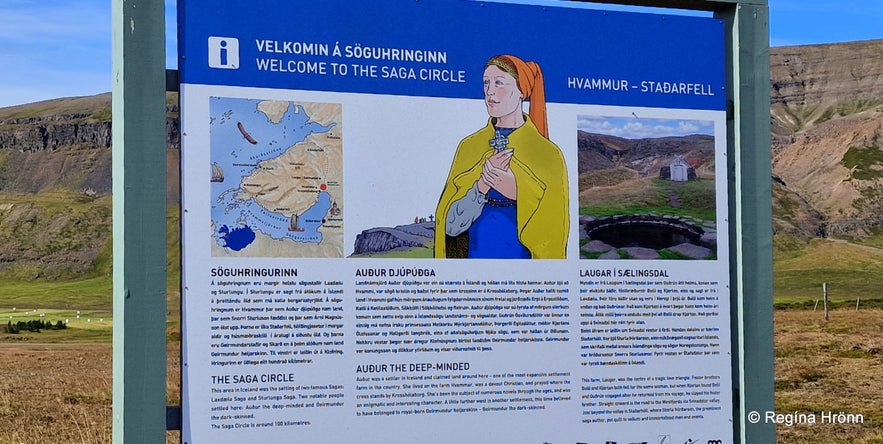
North of the popular Snæfellsnes peninsula in West Iceland, you will find a much less travelled peninsula called Fellsströnd and Skarðsströnd.
This beautiful off-the-beaten-path peninsula is often referred to as the Saga Circle of Iceland.
The Saga Circle of Iceland has many historical places that are well worth visiting. I explored the peninsula for 2 days and stayed for one night at the Vogur country lodge in Fellsströnd.
Krosshólaborg & Auður djúpúðga
The memorial stone cross of Auður djúpúðga
When you turn from road 60 and onto road 590 for Fellsströnd you will notice a big stone cross on top of a hill.
The hill is called Krosshólaborg, and there we made our first stop.
The stone cross is a monument, erected in 1965 in memory of the noted Auður djúpúðga (834-900).
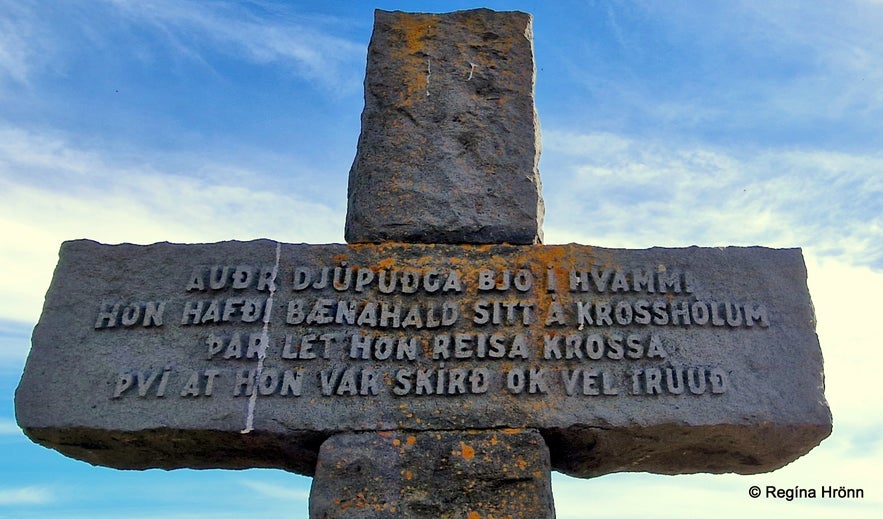
The stone cross at Krosshólaborg
Auður djúpúðga - Auður the deep-minded was Iceland's best-known settler woman and the ancestress of the Laxdæla clan.
She was Norwegian, the daughter of Ketill flatnefur, and several of her siblings settled in Iceland.
Laxdæla Saga, one of the best-known Icelandic Sagas, tells us the story of Auður djúpúðga and the story of her descendants.
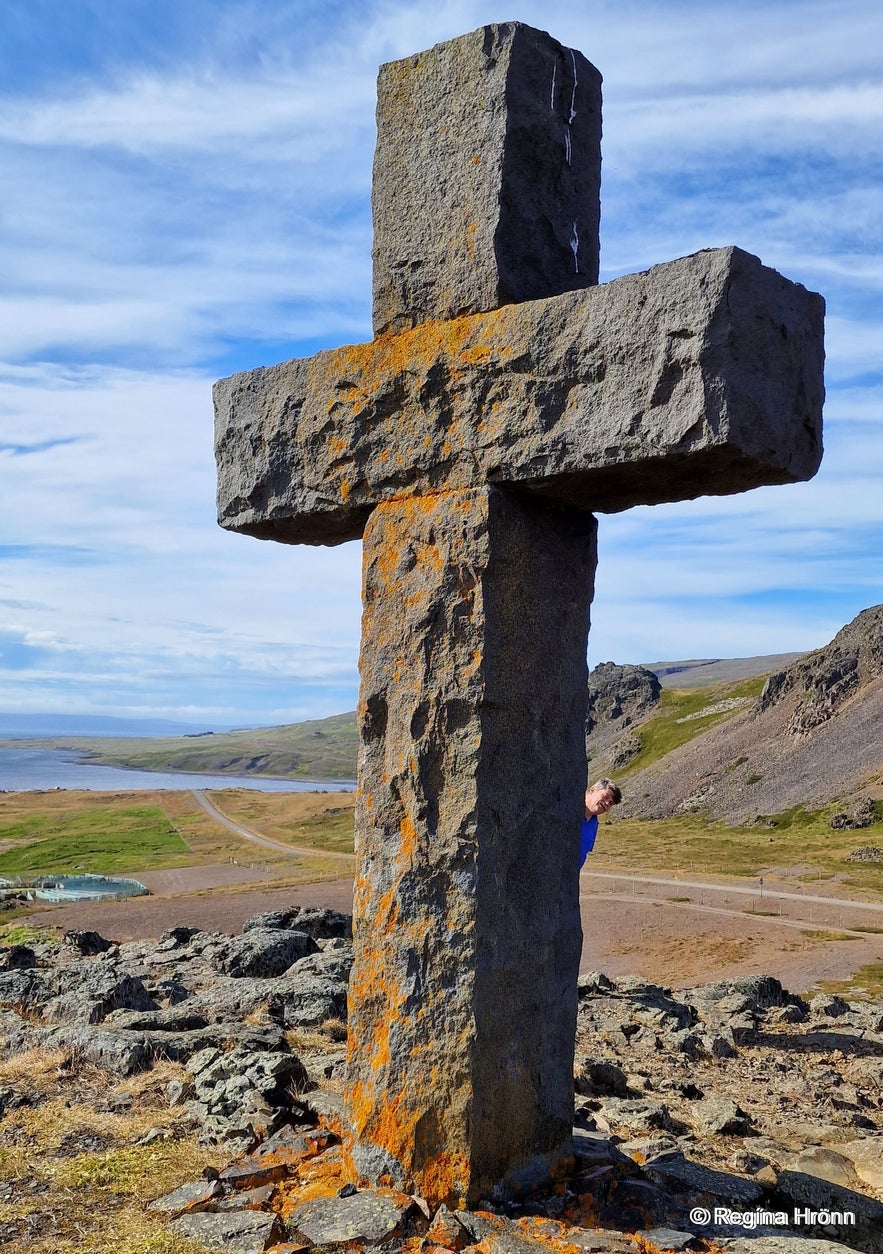 The stone cross is huge
The stone cross is huge
I have told you a little about the descendants of Auður djúpúðga in my very first travel-blog here on Guide to Iceland - the Guðrúnarlaug saga hot tub.
On the stone cross, you will find the following inscription in old Icelandic: "Auðr djúpúðga bjó í Hvammi, hon hafði bænhald sitt á Krosshólum, þar lét hon reisa krossa, því at hon var skírð ok vel trúuð".
Translated into English: "Auður the deep-minded lived at Hvammur, she prayed at Krosshólar hills, where she had crosses erected, as she was baptized and religious".
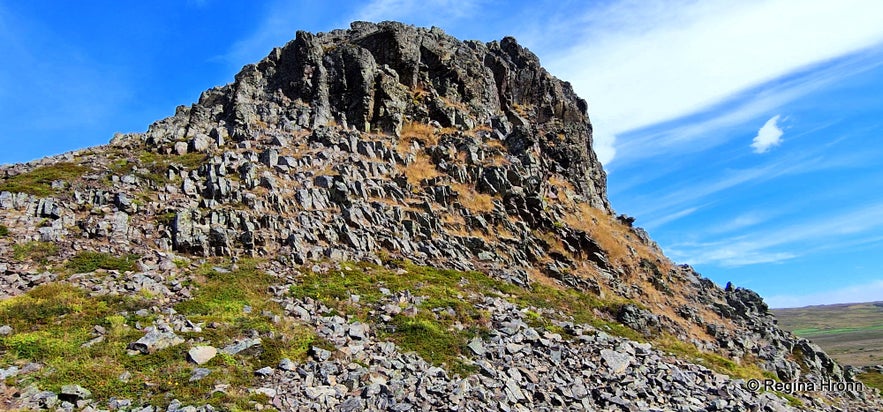 Krosshólaborg cliff
Krosshólaborg cliff
Auður settled in the year 890 at Hvammur in Dalasýsla county, close to where the stone cross stands.
Before she came to Iceland she married Ólafur hvíti or Olaf the White, who conquered Dublin and became a king there.
Auður had one son by Ólafur, Þorsteinn rauður, who married Þuríður, the sister of Helgi magri, who settled Eyjafjörður in North Iceland. Ólafur hvíti got killed in Scotland.

The stone cross at Krosshólaborg
Þorsteinn, their son, who had become the king of Scotland, also got killed and Auður took his widow and 7 children and fled to Iceland.
On the way, she married off two of her granddaughters in the Orkney Islands and in the Faroe Islands.
Auður djúpúðga was one of the few Christian settlers in Iceland and raised crosses on a hill close to where she lived and where she went to pray. Thus the name Krosshólar or Cross-Hills.
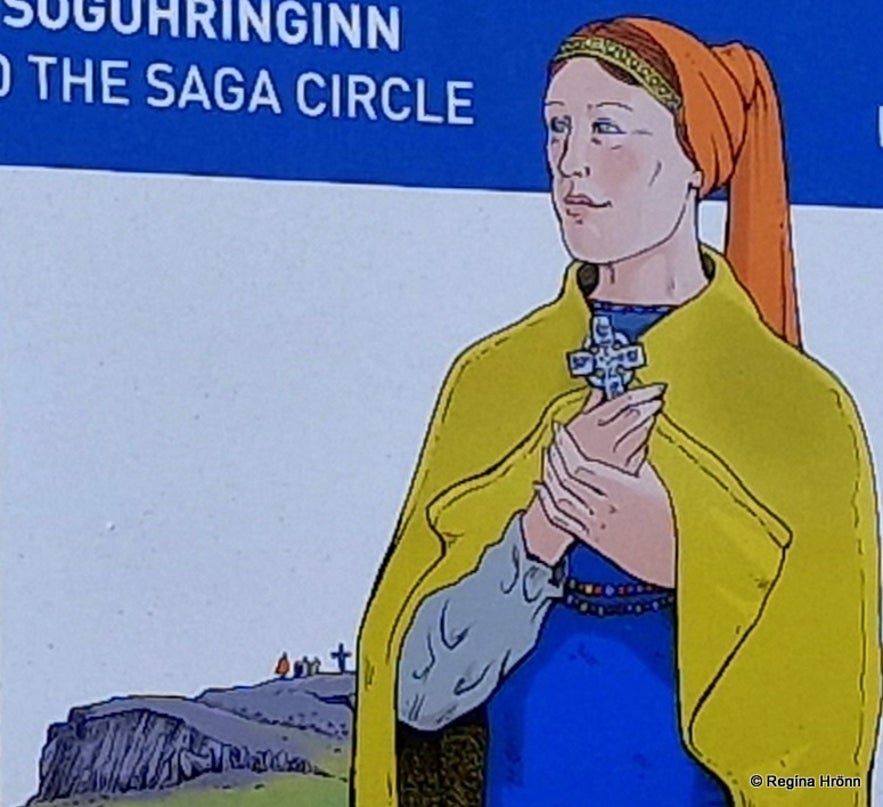 Auður djúpúðga as depicted on the Saga Circle information sign
Auður djúpúðga as depicted on the Saga Circle information sign
Auður djúpúðga was the daughter of Ketill flatnefur and the sister of Þórunn hyrna, who married Helgi magri and settled in Eyjafjörður.
The children of Katell flatnefur settled a big part of Iceland.
Helgi bjóla settled Kjalarnes and Björn austræni settled Snæfellsnes and lived in Bjarnarhöfn. At Bjarnarhöfn you will now find a popular shark museum.
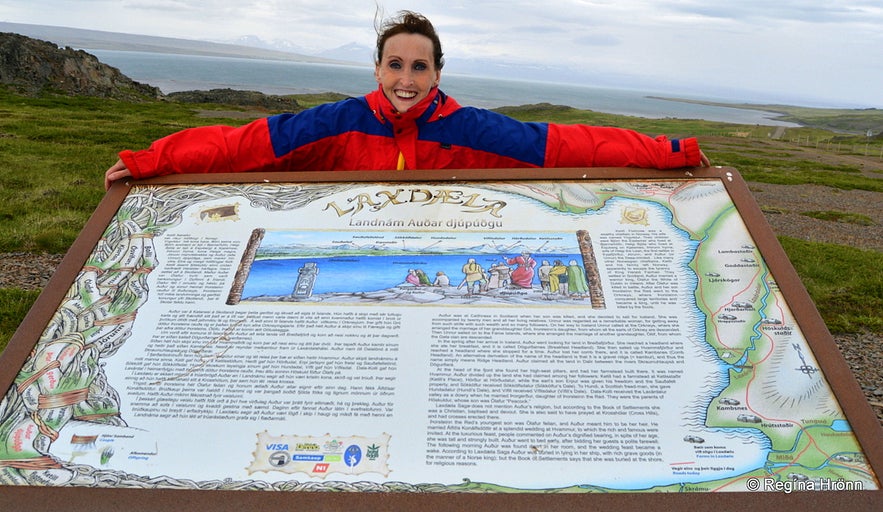
The information sign by Krosshólaborg
On one of my visits to Krosshólaborg, it was so windy that I could barely stand on my feet.
By the parking lot, you will find an information sign on the Settlement of Auður djúpúðga. I also had to hold onto the sign while the photo was taken so as to not fly away!
Hvammur í Dölum - Hvammur at Dalir
The information sign by Hvammur in Dalir
My next stop was at Hvammur, which was the leading manor in this area. Here was the home of Auður djúpúðga.
Later on, Hvammur became the home of Sturla Þórðarson (1115-1183) Hvamm-Sturla, who was the 9th generation of Auður djúpúðga's descendants.
Snorri Sturluson's monument at Hvammur
Sturla Þórðarson was the father of one of the biggest and most influential Viking clans in Iceland, the Clan of the Sturlungs, but you can read about their story in Sturlunga Saga.
Here his son, Snorri Sturluson (1179-1241), maybe the most influential man in Iceland's history, was born in 1179.
I am the 31st generation of Auður djúpúðga's descendants and the 22nd generation of Snorri Sturluson's descendants :)
 The memorial stone for Snorri Sturluson is huge
The memorial stone for Snorri Sturluson is huge
Snorri was fostered by Iceland's lawspeaker, Jón Loftsson, at one of the primary cultural centres in Iceland, Oddi in South Iceland, when he was only 3 years old.
Later on, he lived at Reykholt in West Iceland and was mercilessly killed on his estate by his enemies.
Snorri was one of the richest and most powerful men in Iceland of his time. He was a chieftain, historiographer, poet, and Saga writer.
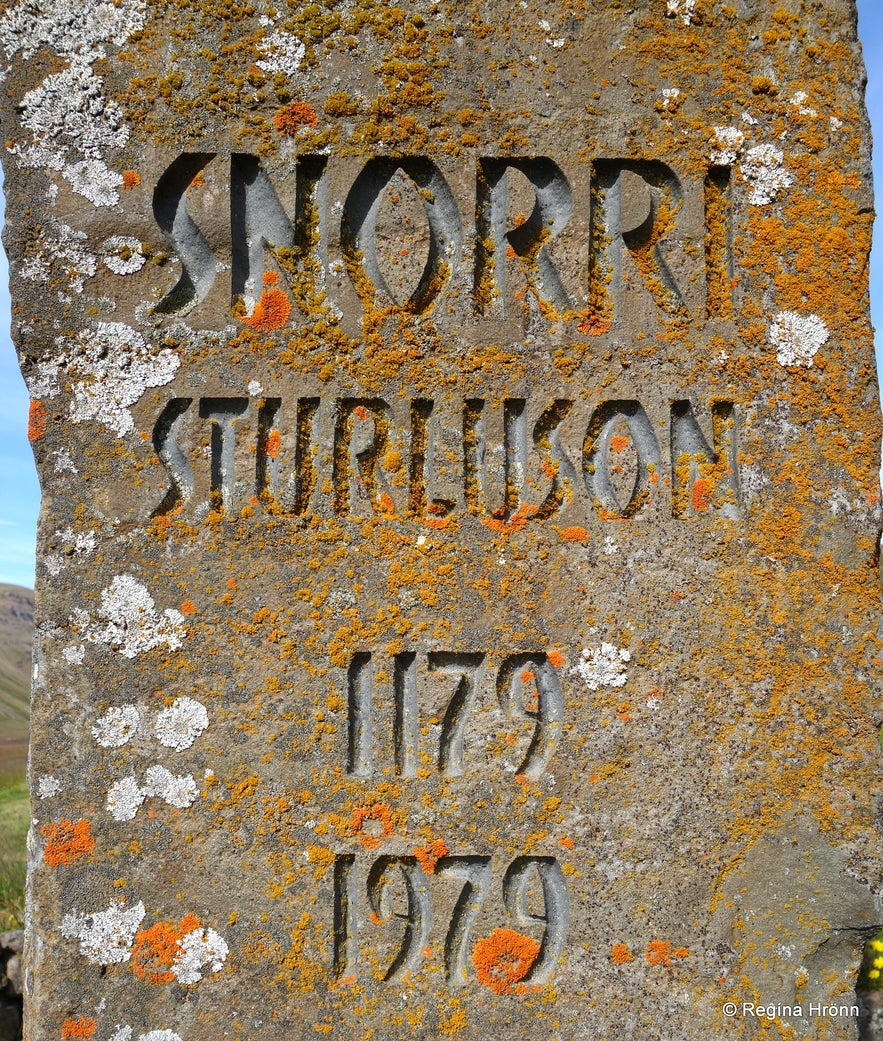
The Snorri Sturluson monument at Hvammur
Snorri was the author of the history of the Norwegian kings, called Heimskringla. And he wrote Prose-Edda about Nordic mythology and poetry.
Snorri Sturluson might also be the author of the Saga of Egill, about Egill Skallagrímsson and the settlers of Borgarfjörður in West Iceland.
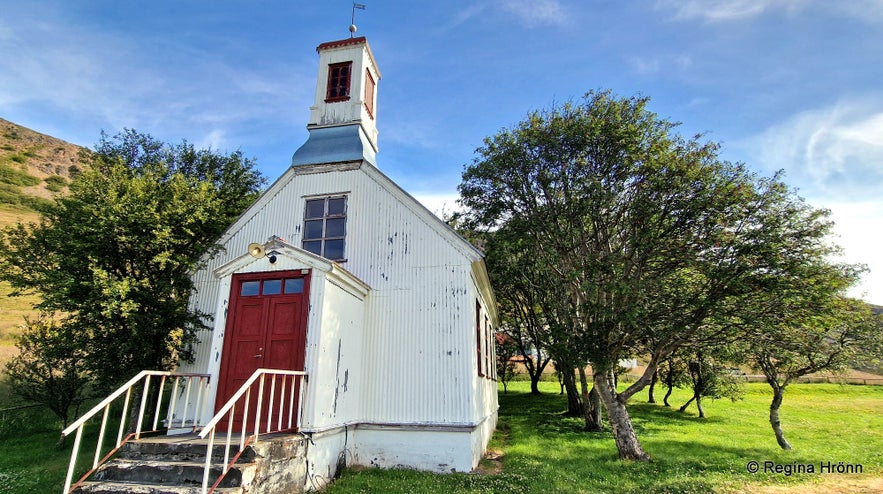 Hvammskirkja í Dölum - it was locked when we visited it for the 3rd time
Hvammskirkja í Dölum - it was locked when we visited it for the 3rd time
When you visit Hvammur you will find a monument by the Hvammskirkja church in the memory of Snorri Sturluson.
Hvammskirkja church is one of 5 churches on this peninsula.
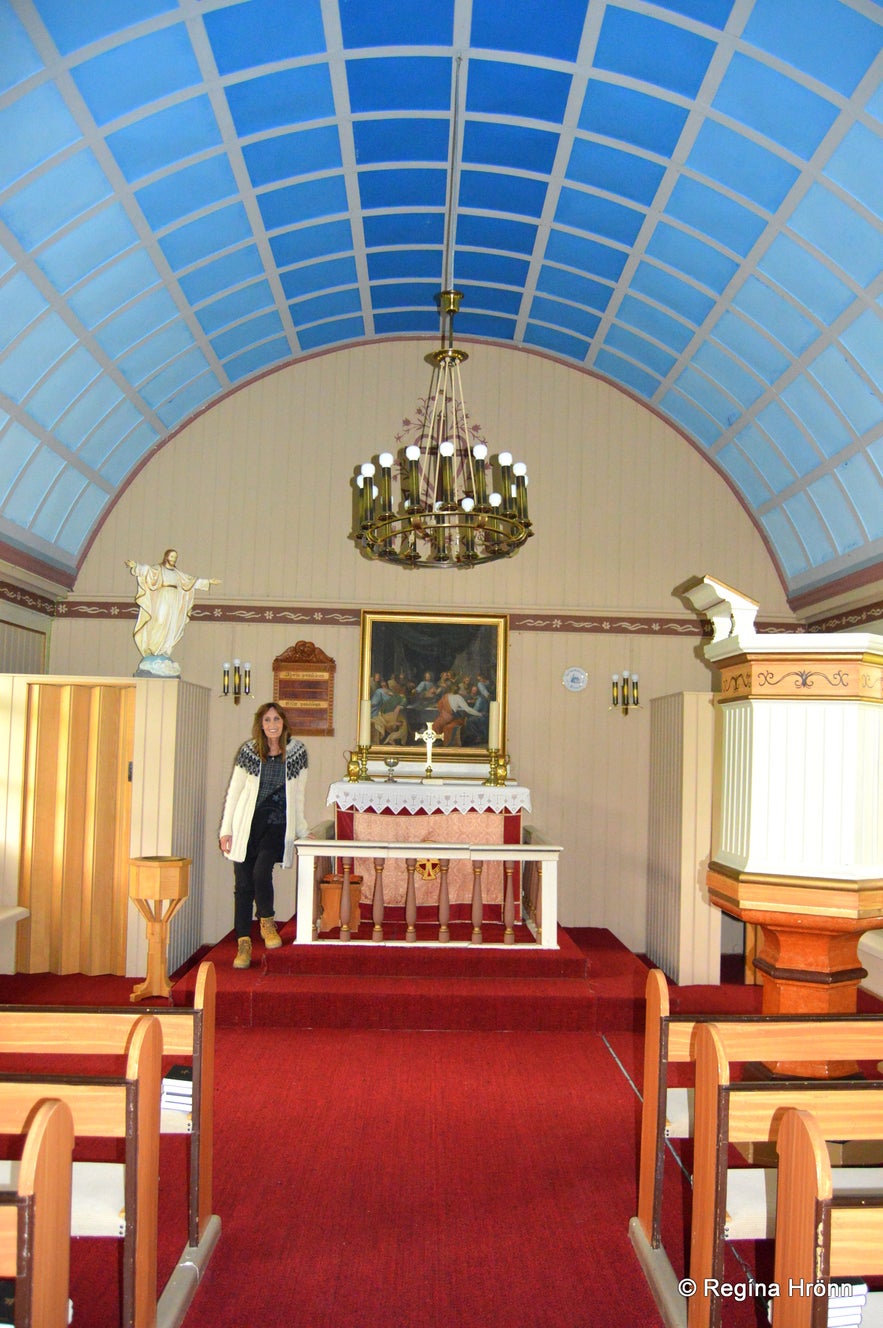 Hvammskirkja í Dölum
Hvammskirkja í Dölum
The other churches, by all of which I made a stop, are Staðarfellskirkja, Dagverðarneskirkja, Skarðskirkja, and Staðarhólskirkja church.
Check out my travel-blog on Snorri Sturluson to find out more about the life of this extraordinary chieftain.
Staðarfell
Staðarfell
The next stop we made was at Staðarfell, where we visited Staðarfellskirkja church, a timber church, built in 1891.
This is another historical place here on the peninsula, but there has been a church here since the year 1200.
Guðrún Ósvífursdóttir lived for a while at Staðarfell and Þórður Gilsson, the father of Hvamm-Sturla at Hvammur and the grandfather of Snorri Sturluson, Sighvatur and Þórður of the powerful Viking Clan of Sturlungar.

Inside Staðarfellskirkja church at Staðarfell
And Hallgerður langbrók from the Saga of Njáll lived at Fell with her first husband, Þorvaldur.
In the old school building at Staðarfell, the SÁÁ rehabilitation centre for recovering alcoholics was operating when we visited, but they operated their rehabilitation centre there since 1980.
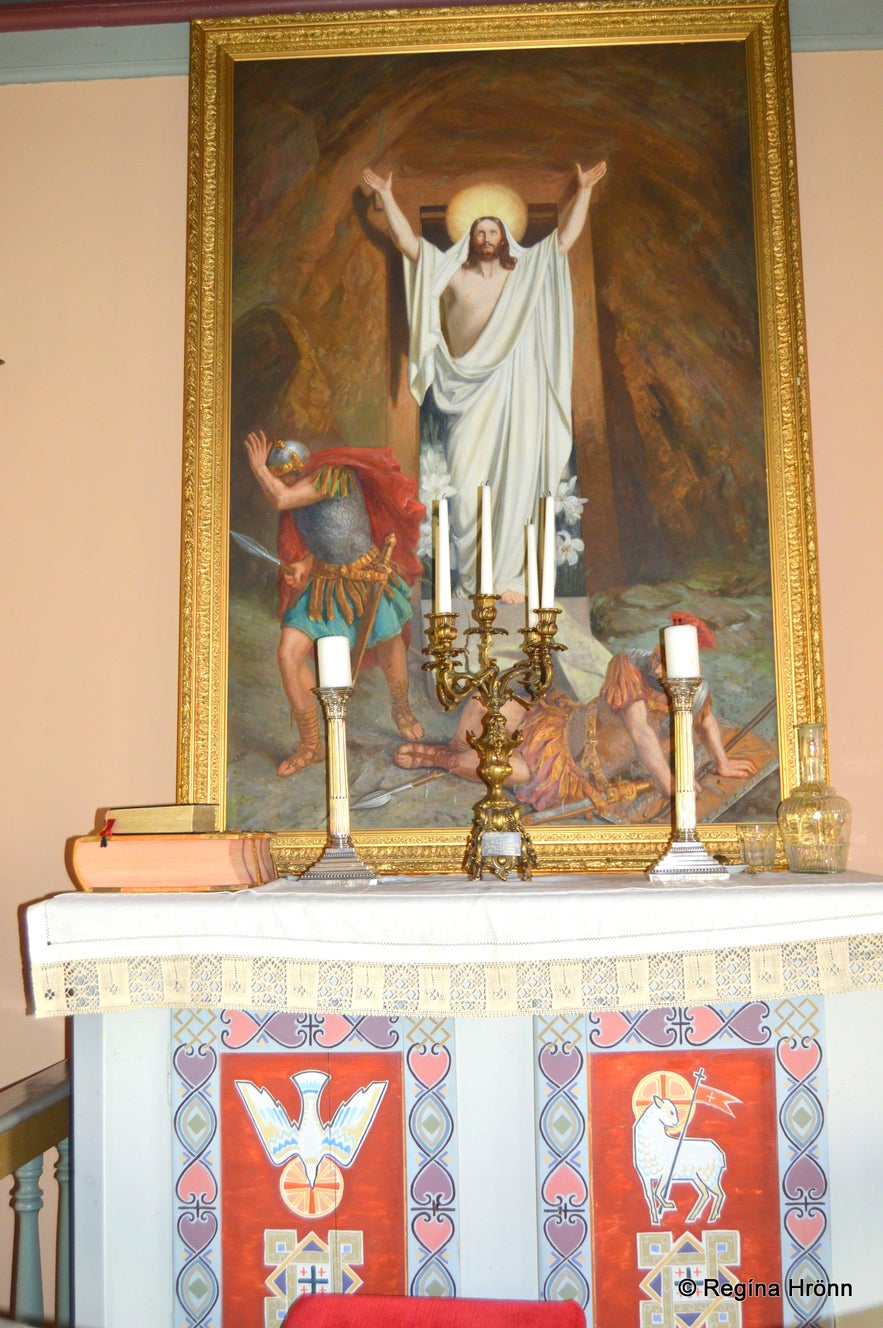 Inside Staðarfellskirkja
Inside Staðarfellskirkja
The building housed a homemaking school for 50 years before SÁA moved in.
I saw in the news in 2017 that Staðarfell was for sale and that the rehabilitation centre will be moved to Kjalarnes in SW Iceland.
Vogur at Fellsströnd
Vogur at Fellsströnd
We reached Vogur Country Lodge at Fellsströnd in the evening.
My aunt had stayed at this hotel on two occasions and was raving about it, telling me that I had to visit Fellsströnd and stay at this hotel. And that I should write about this area on Guide to Iceland :)
I was thrilled when I saw my room and now know why my aunt had liked staying here so much. Everything is new, modern, and tastefully decorated. And spotlessly clean.
My room at Vogur Country Lodge
Vogur Country Lodge was renovated in 2012 and opened in January 2013. It is a converted barn, beautifully renovated. There are 24 rooms and 4 suites here.
There is also a barbecue hut at Vogur, where one can grill one's own food. You can also use the outside hot tub at Vogur and sauna.
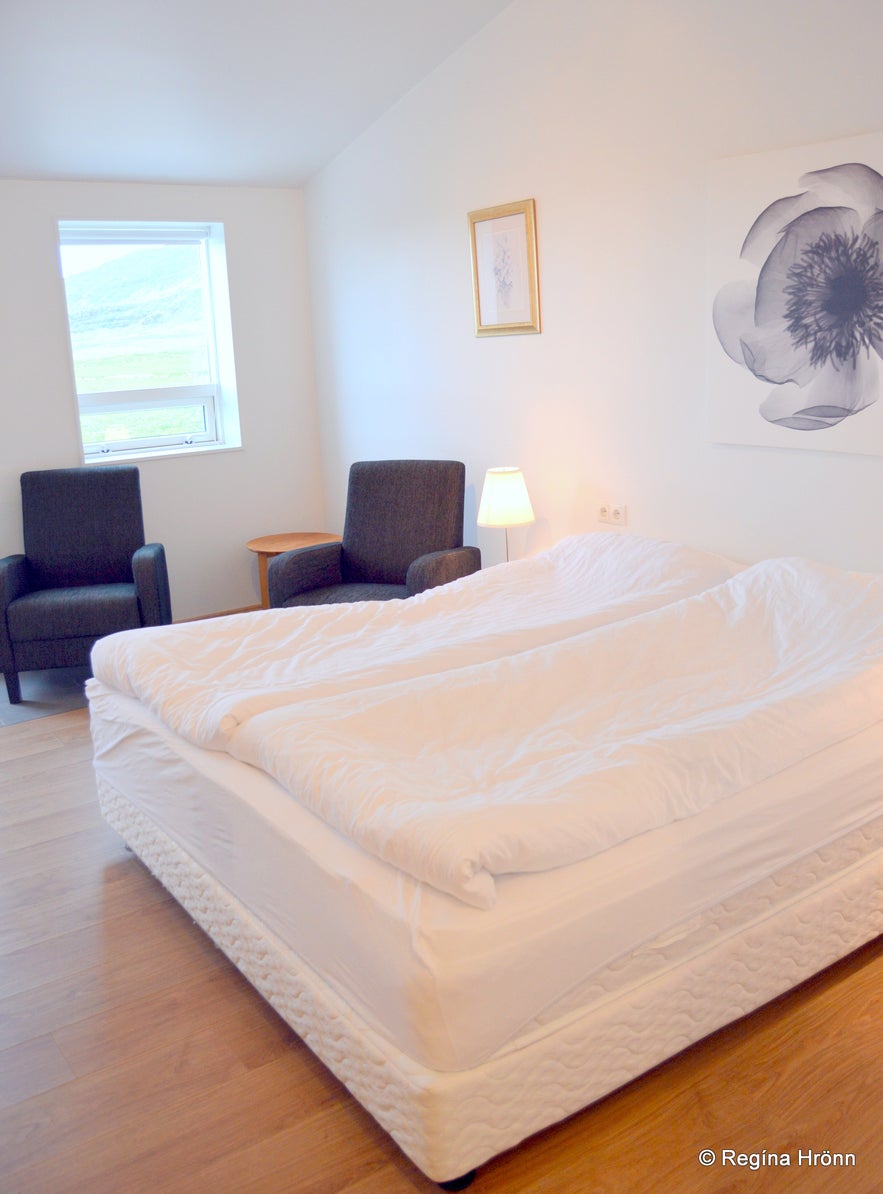 My room at Vogar the morning after in a different light
My room at Vogar the morning after in a different light
We dined at Vogur in the evening in the dining hall and got excellent food.
My husband and I were celebrating our "2-years-together" anniversary, and it just hit the spot staying in such a beautiful place.
The hotel offers boat trips to the Breiðarfjörður islands and rents out bikes to their guests. You will find a horse rental close to Vogur, so there is a lot to do for fun in this area.
At Vogur Country Lodge
I was here to explore the area and the history of the peninsula, which is also fun to do.
Above Vogur Country Lodge is a lovely, small waterfall, so after dinner, we went on a short hike (15 minutes) up to the waterfall and enjoyed the breathtaking view of Breiðafjörður bay with its innumerable islands.
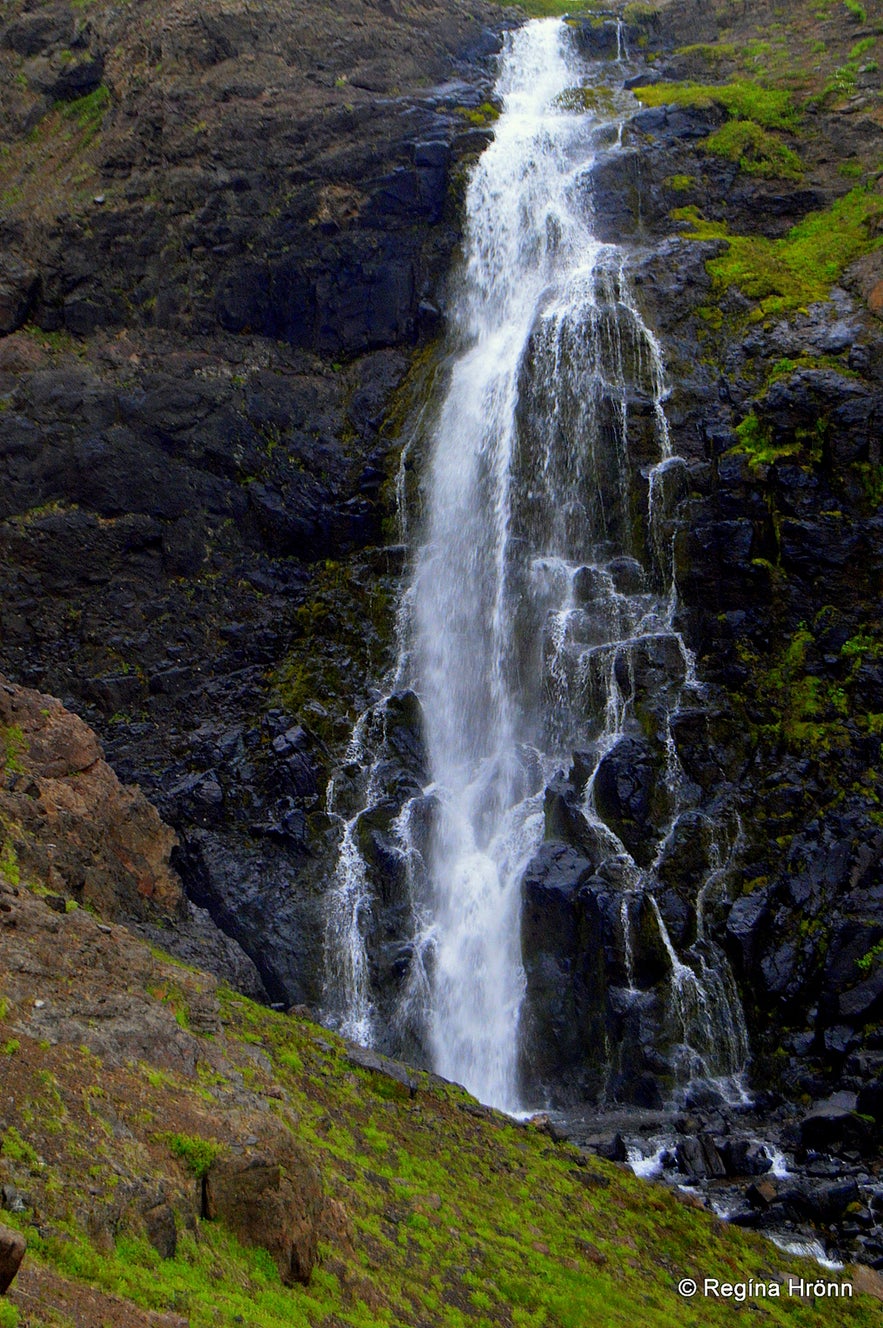 The waterfall at Vogur
The waterfall at Vogur
The following day, we made an early start so we would be able to visit all the major sights in this area.
I take a lot of photos, so travelling with me can be trying as I want to stop so often ;)
The Memorial Grove of Bjarni from Vogur
The Memorial Grove of Bjarni from Vogur
Our first stop the following day was just outside Vogur Country Lodge at a beautiful Memorial Grove in memory of Bjarni from Vogur.
Bjarni from Vogur (1863-1926) was a well-known Icelander, a politician, writer, and a university teacher. He has, funnily enough, a cigar brand named after him. On every box of cigars was written "Bjarni frá Vogi" with a photo of Bjarni and the Icelandic flag colours.
Dagverðarnes cape
Dagverðarneskirkja church at Dagverðarnes cape
After visiting the memorial grove and making many photo-stops we drove to a peninsula called Dagverðarnes cape.
When the settler woman Auður djúpúðga and her men were looking for their high-seat pillars, they apparently went to this cape and had breakfast.
The peninsula got its name from the lunch "Dagverðarnes" cape meaning Breakfast cape.
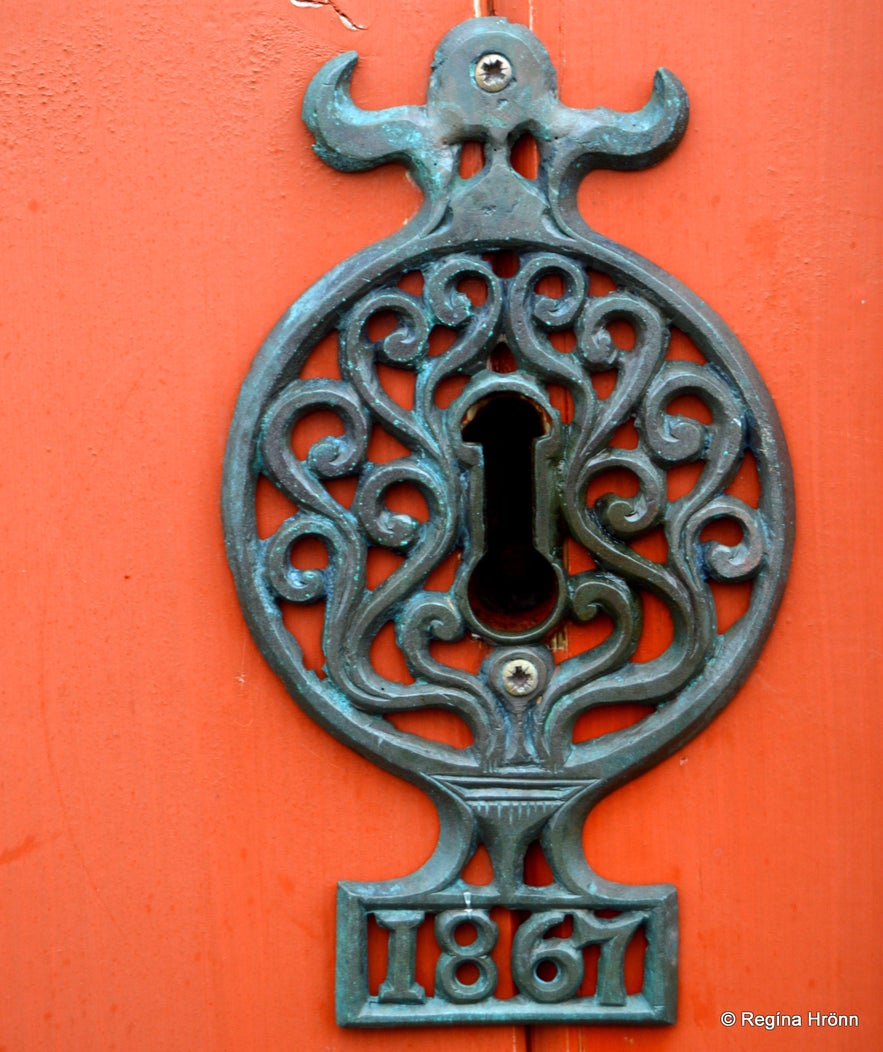
Dagverðarneskirkja church
A small church, Dagverðarneskirkja, on the very end of the cape, is now abandoned and locked.
On the door of the church, I noticed the date 1867.
But from what I have read then there has been a church here since 1758. The current church was rebuilt in 1934 and is now protected.
 Dagverðarneskirkja church
Dagverðarneskirkja church
It is kind of surreal standing by the church. One gets the feeling of being alone in the world, looking at the innumerable Breiðafjörður islands. It is so silent and so remote.
The trail leading to the church is 5 km long.
Klofningur
The view-dial at Klofningur
My father-in-law, Jakob Hálfdanarson, designs view-dials, and my husband and I stop by every view-dial in Iceland, given that they are not located on mountain tops, and photograph them and the surroundings.
There is a view-dial at Klofningur west of Dagverðarnes cape with a beautiful view of the Breiðafjörður islands.
Jakob designed this view-dial back in 1999, and it was erected by Ferðamálafélag Dala og Reykhólahrepps in August 2000.

By the view-dial at Klofningur in the rain and wind that made my photos dark and gloomy
From here, and in other places at Fellsströnd, one can see two cones in the sea. These cones are called Dímonarklakkar islands, and they are the highest islands in the Breiðafjörður bay, 39 meters high.
I have sailed right up to them on a boat trip on the Breiðafjörður bay.
Unfortunately, it was not sunny when we visited, but my aunt tells me that it is breathtaking watching the sunset on a clear day from this place. I hope I will be able to visit again on a sunny day.

Klofningur
Klofningur means a split, and the road lies through the split. It makes for a good photo opportunity to drive the car through the split and turn around, and take a photo of the car driving through the split again.
Skarð at Skarðsströnd
Skarðskirkja church at Skarðsströnd
By now, we had reached the Skarðsströnd part of the peninsula, and our next stop was at the historical farm, Skarð. Skarð used to be one of the splendid manors in Iceland.
The same lineage has been living at Skarð since the 11th century, and the farmers at Skarð today are the 27th generation from Húnbogi Þorgilsson, who lived at Skarð in the 11th century.
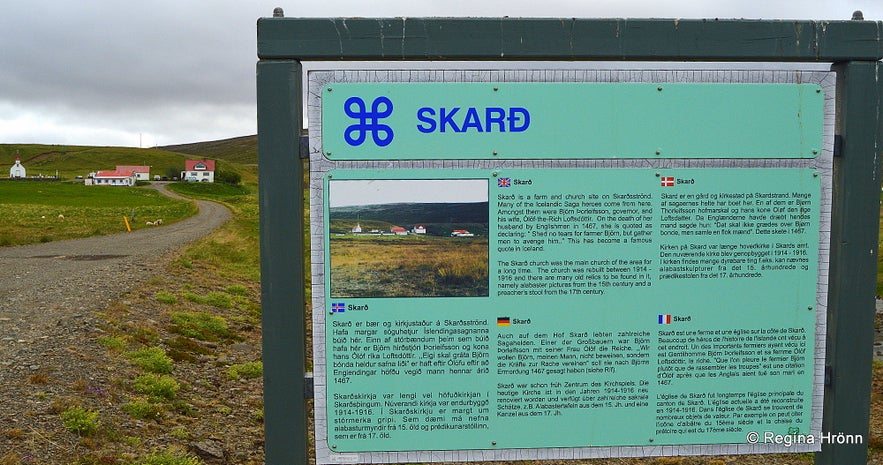 The information sign by Skarð
The information sign by Skarð
I have also met the 29th and 30th generation, as the granddaughter of the farmers at Skarð was working in the reception at Vogur Country Lodge (and she was carrying her daughter, who is the 30th generation).
Here at Skarð lived Björn Þorleifsson, governor, and his wife Ólöf-the-Rich Loftsdóttir.
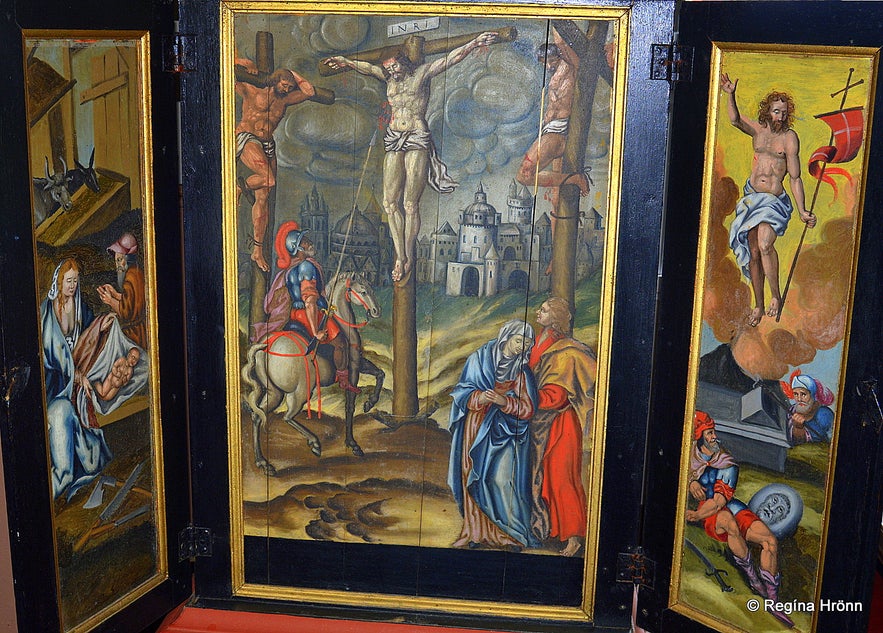
Inside Skarðskirkja church at Skarðsströnd
Englishmen killed Björn in 1467 at Rif on the Snæfellsnes peninsula, and Ólöf-the-Rich is quoted to have said: "Eigi skal gráta Björn bónda, heldur safna liði og leita hefnda..." - meaning "Shed no tears for farmer Björn, but gather men to avenge him...". I think almost every Icelander of age knows this quote.
Ólöf revenged her husband and had her men kill some of the Englishmen and imprison 50 of them. She kept the men imprisoned and used them as slaves.
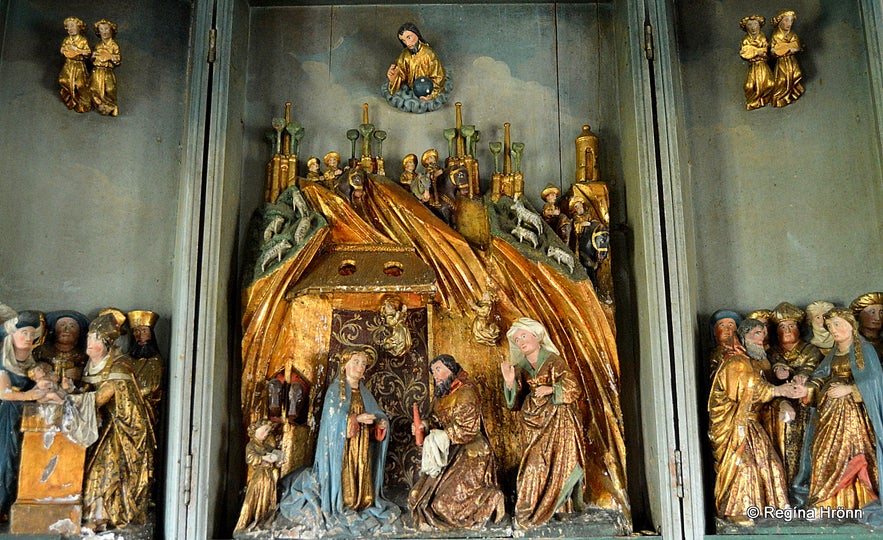
Inside Skarðskirkja church at Skarðsströnd
She forced them to build a pavement of rock, which can still be seen at Skarð. She then had them all killed.
The church at Skarð was the main church for this area, and inside treasures can be found. A beautiful alabaster artwork above the altar dates back to the 15th century.
It was donated to the church by Ólöf-the-Rich, and in the middle, we can see Ólöf herself to the right giving blessings to the congregation.
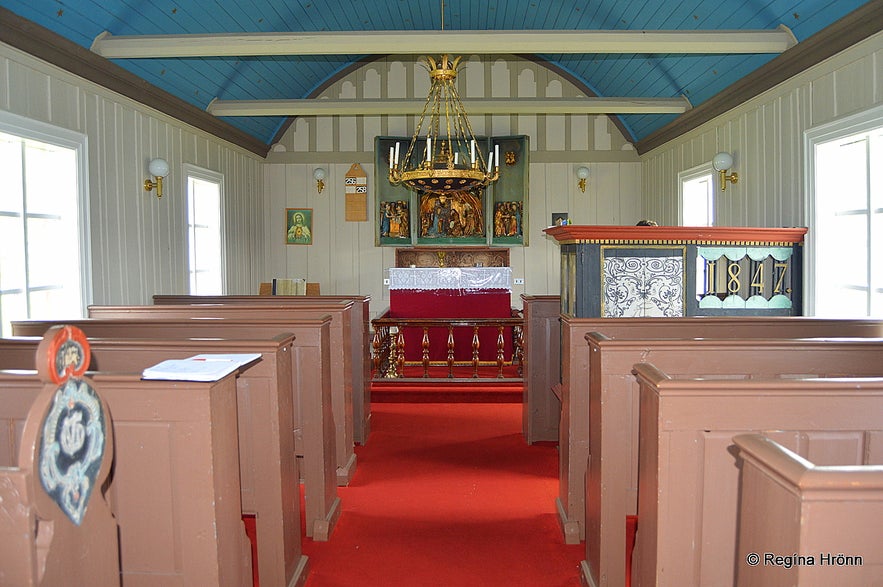 Skarðskirkja church
Skarðskirkja church
Ólöf is buried beneath the altar, and her husband, Björn, is buried beneath a rock on the south side of the church, the farmer at Skarð told us.
A beautiful pulpit in this church had the date 1847, but seems to date back to the 17th century.
The pulpit was donated in memory of Daði Bjarnason and his wife, Arnfríður, who were farmers at Skarð.
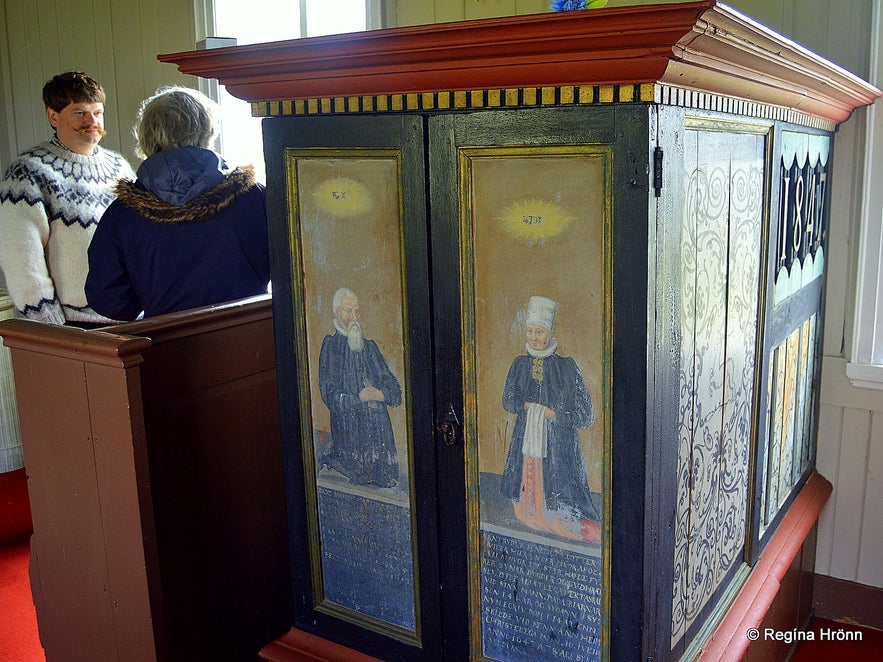
Inside Skarðskirkja church at Skarðsströnd
The farmers at Skarð gave us a guided tour of the church, for which we paid a small fee, and told us the amazing history of Skarð. I recommend stopping at Skarð for a guided tour of the church.
The farmers at Skarð specialize in eiderdown production, which they sell to Japan.
Grafardrangur
Grafardrangur
After an hour's visit to Skarð, we visited the remaining sights on Skarðsströnd. We passed the magnificent Grafardrangur in Mt. Grafarfjall, where the sword of the Viking settler, Geirmundur heljarskinn, is supposed to be buried.
Geirmundur heljarskinn has been called the noblest of the Viking settlers, but he was the son of the Norwegian king Hjör and Princess Ljúfvina from Bjarmaland.
Geirmundur lived at Geirmundarstaðir at Skarð and was very powerful and always travelled in the company of 80 men.
 Grafardrangur is a huge lava dyke
Grafardrangur is a huge lava dyke
Geirmundur also had 4 farms in Hornstrandir.
He had a twin brother, Hámundur heljarskinn, who settled in Eyjafjörður with Helgi magri, and was married to the daughter of Helgi magri.
An abandoned mine by the sea
An abandoned mine by the sea
We next stopped by an abandoned coal mine by the seashore. Coal was mined here from around 1890 until the middle of the 20th century.
Here, one can see a small railway track and the remains of a bridge, which makes for a good photo opportunity.
Lignite (surtarbrandur) was mined here at Tindanáma in the middle of the 20th century.
 Nowadays, the algae factory at Reykhólar harvests seaweed from the sea, and if you look closely, you can sometimes see them working on orange machinery harvesting the seaweed from the sea below the road on Skarðsströnd.
Nowadays, the algae factory at Reykhólar harvests seaweed from the sea, and if you look closely, you can sometimes see them working on orange machinery harvesting the seaweed from the sea below the road on Skarðsströnd.
Staðarhólskirkja church and the monuments
Staðarhólskirkja and the monuments
Now we had come to our final stop on this tour around the peninsula - Saurbær.
Below Staðarhólskirkja church, you will find a monument; 3 different pillars in remembrance of 3 great poets, the Dalaskáld poets, who have had links to this area.
These poets are Stefán from Hvítidalur, Steinn Steinarr, and Sturla Þórðarson, but Sturla (1214-1284) lived in the 13th century at Staðarhóll in Saurbær and was a member of the Viking Clan of Sturlungar - and the nephew of Snorri Sturluson himself.

The information sign by the 3 pillars
Sturla Þórðarson was one of the influential men of the Age of the Sturlungs, and not only a poet, but a great historian, a chieftain and a Lawspeaker at Alþingi, and a politician.
He wrote f.ex. Íslendingasaga - the Saga of the Icelanders, which is a part of Sturlunga - the Saga of the Sturlungs.
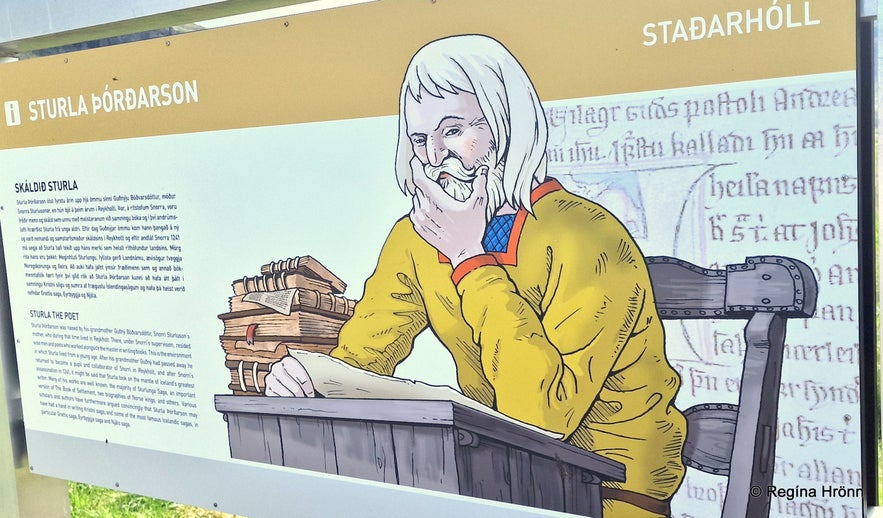 A Saga sign at Staðarhóll
A Saga sign at Staðarhóll
Sturla fought alongside the Clan of Sturlungar in 1238 in the biggest Viking battle - Örlygsstaðabardagi in Skagafjörður, where some 2,800 Vikings took part in a very bloody battle among the most powerful Viking clans.
There in the battle, his uncle Sighvatur fell together with Sighvatur's 4 sons.
Sturla was given a pardon after the battle, as his blood-brother was a member of the opposite clan.
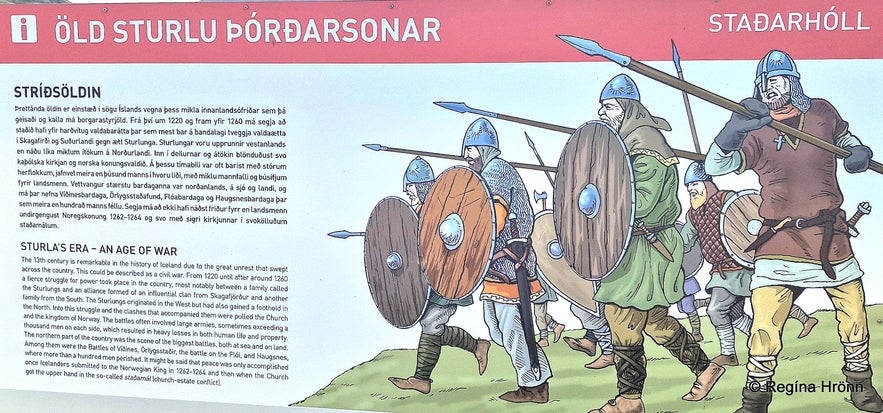 One of the information signs at Staðarhóll - the sun was right behind the sign
One of the information signs at Staðarhóll - the sun was right behind the sign
If you drive to Staðarhóll, you will find many information signs about Sturla Þórðarson.
And at Sturluhátíð festival in the summer of 2025, a new Saga sign was revealed in the presence of a crowd.
So many Icelanders are interested in the Sagas and the Age of the Sturlungs. It was great fun and we got such beautiful weather. I took a video of the unveiling of the new information sign at Staðarhóll.
The Saga Circle is approx. 100 km long, and there is no gas station on the peninsula, so remember to fill up on gas in Búðardalur village before turning off road 60.
I didn't know this and almost ran out of gas, i.e. I had to choose between driving into the valley to the last farm in the valley, to borrow the key from the farmer, or driving to the next gas station. We chose not to run out of gas.

Staðarhólskirkja church
When I attended the Sturluhátíð festival, I started talking to the man standing next to me. He told me that he was the keeper of the Staðarhólskirkja church key.
And he opened Staðarhólskirkja church for the guests at the festival, and I could finally see what this beautiful church looks like on the inside.
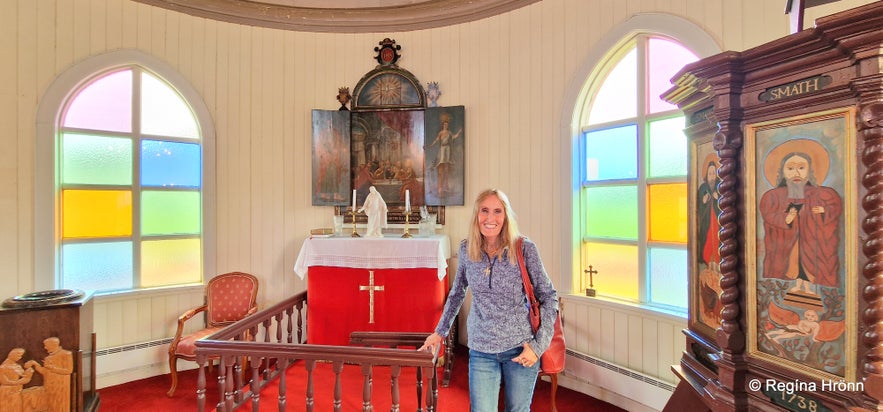 Inside Staðarhólskirkja church
Inside Staðarhólskirkja church
The first records of a church at Staðarhóll date back to around the year 1200, but the current church dates back to 1899.
In 1981, it blew from its foundations unto the community hall next to it (yes, it can be windy here on the peninsula, as I experienced) and was rebuilt.
Nothing got damaged, apart from the hand of the Jesus statue broke off, but it was glued back on.
 The altar at Staðarhólskirkja church
The altar at Staðarhólskirkja church
The reason why the churches are closed is due to vandalism and sacrilege in some of the churches. I find it very sad that the churches around Iceland have to be locked due to vandalism.
Now that they are locked, we have to bother the farmer for the key to the church, and sometimes it is not possible to enter the churches.
We now turned back onto road 60 towards Búðardalur village and stopped at Guðrúnarlaug hot tub as we always do before continuing on our way to the Snæfellsnes peninsula.
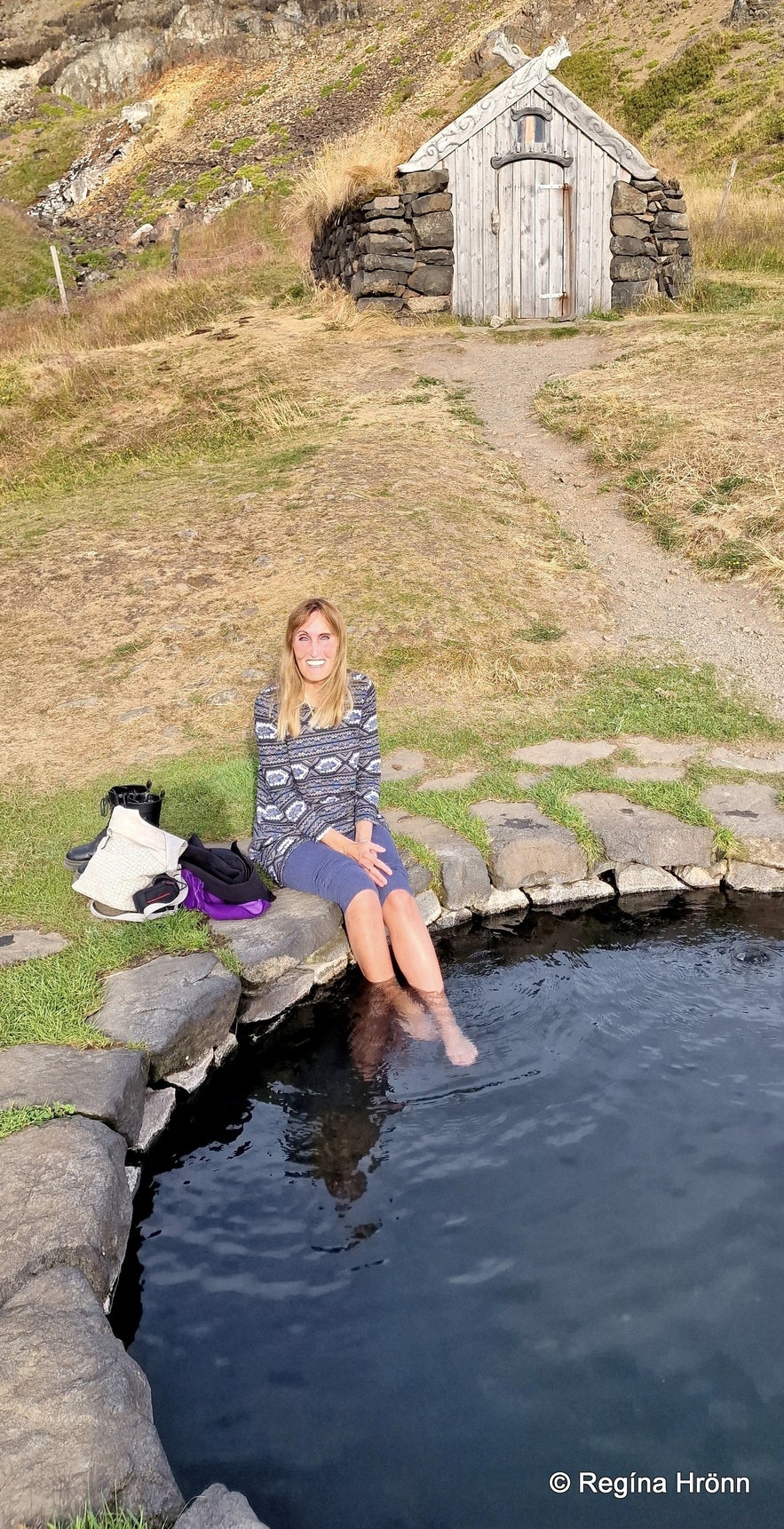
By Guðrúnarlaug in Sælingsdalur valley
It had been lovely and informative visiting the peninsula, and I am glad we didn't rush through it and stayed at the peninsula for the night.
This peninsula is off the beaten track, and it has been said that time stands still here. So if you want to see a different side of Iceland, do pay Fellsströnd and Skarðsströnd a visit.
To me, it felt like stepping back in time, from back when I was travelling with my family. Then, very few tourists visited Iceland, and we had the roads almost to ourselves when we were travelling.
You can visit this area by renting a car in Reykjavík and drive to the west. The road number for the peninsula is 590.
Here is the location of Fellsströnd on Google Maps.
Sources:
25 Gönguleiðir í Borgarfirði og Dölum, Reynir Ingibjartsson


